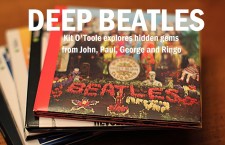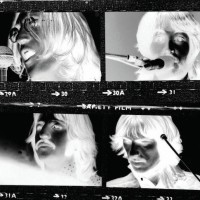The year 1967 marked a crucial transition for the Beatles: They recorded the groundbreaking Sgt. Pepper’s Lonely Hearts Club Band, performed “All You Need Is Love” on the Our World broadcast, studied Transcendental Meditation under the Maharishi Mahesh Yogi – and suffered the tragic death of manager Brian Epstein.
In the midst of all of this, the Beatles also had to fulfill their contract with EMI to release another feature film. Paul McCartney presented the other Beatles with a rough sketch – a pie chart, to be exact – for a new movie. The concept: The Beatles would board a bus with a variety of friends, character actors, vaudevillians, and sideshow acts; in between “dream” sequences, the camera would simply film whatever happened.
The result, Magical Mystery Tour, premiered on Dec. 26, 1967 and remains the subject of debate among Beatles fans: Was it an underrated exercise in avant garde art, or simply four guys playing around with cool cameras? Then there was the fact that the film originally aired on the BBC in black and white. Anyone expecting the lighthearted romps of A Hard Day’s Night and Help! must have been shocked while watching, plus the movie’s psychedelic quality was blunted by the lack of color.
Critics savaged the film, fans scratched their heads, and the Beatles experienced their first critical and commercial flop. But all was not lost.
Most agree that the musical sequences hold up best; in fact, they effectively foreshadow elaborate music videos that would be made decades later. At the same time, these songs created the foundation for a critically acclaimed album in the Beatles catalog. Despite mixed reviews, Magical Mystery Tour featured some of the more adventurous music they had attempted up to that point – in particular “I Am the Walrus.”
McCartney contributed strong tracks as well, including “Fool on the Hill,” the charming “Your Mother Should Know,” and the title song. U.S. and later editions of the soundtrack were expanded with singles not used in the film, but recorded around the same period: “Hello, Goodbye,” “Strawberry Fields Forever,” “Penny Lane,” “Baby You’re a Rich Man,” and “All You Need Is Love.” The expanded LP topped the album charts in the U.S. and Britain, and its songs have been covered by countless artists.
In the meantime, a proper negative of the movie was reportedly never preserved. Magical Mystery Tour went out of print for a time, but even the odd reissues were marred by grainy, dark film quality. Restorers finally corrected things with a deluxe 2012 remastering that enhanced the color and eliminated as much graininess as possible. The sound was also at last rendered crystal clear.
George Harrison’s “Blue Jay Way” sequence particularly benefited from this update, as its psychedelic, otherworldly quality shined through. “I Am the Walrus” maintained its playfully surreal mood, while the “Fool on the Hill” segment appeared both silly and serious with McCartney cavorting through the hills of Nice, France. The ending “Your Mother Should Know” still played like Busby Berkeley on acid, with the white suit-clad Beatles executing what could be loosely termed “choreography” while wearing broad grins, as if in on a private joke.
In an accompanying director’s commentary as well as a “making of” featurette, McCartney argued that Magical Mystery Tour was meant to be an experiment in surrealism, asserting that Steven Spielberg studied the movie in film school as an example of “making a film in a different way.” However, McCartney also admitted that the stripper segment and other scenes of scantily clad women were inserted essentially because the Beatles liked to look at ladies – hardly an example of serious filmmaking.
In his interviews, Ringo Starr took a noncommittal stance, mainly concentrating on the fun he had acting and experimenting with camera angles and editing. Behind-the-scenes footage showed him improvising with “Aunt Jessie,” with McCartney giving direction like this: “OK, Ringo, you and Aunt Jessie are going to just say some stuff. Go!”
Other bonus features from the expanded reissue included an interesting overview of the cast. Who knew that Jessie Robins could play decent drums? (“Go Jessie!” Starr yells while watching footage of Robins in action.) Fawlty Tower fans will enjoy hearing that Derek Royle, AKA “Jolly Jimmy,” once guested on a very famous episode. The original video to “Hello, Goodbye,” first aired on Top of the Pops in 1967, was also included – as were new videos for “Your Mother Should Know,” “Blue Jay Way,” and “Fool on the Hill,” which were cleverly compiled from outtakes and rare footage.
Two segments omitted from the film, “Nat’s Dream” (directed by John Lennon) and “I’m Going in a Field,” generated only mild interest – although the former segment did demonstrate how vaudevillian and absurdist humor clearly influenced Lennon: Think Monty Python crossed with Benny Hill, with just a touch of Charlie Chaplin. As a side note, the Lennon-penned “Buster Bloodvessel” dream, with Aunt Jessie being fed copious amounts of spaghetti, may very well have been the inspiration for Monty Python’s infamous (and disgusting) “Mr. Creosote” scene in The Meaning of Life.
Of course, no reissue of Magical Mystery Tour – whatever its visual qualities or extras – is likely to change minds at this point. Those who dislike the film will continue to do so, while those who deem it an under-appreciated classic will feel vindicated. Yet the movie represents an important stage in Beatles history, as the group would soon transition from the psychedelic phase into their final, straightforward rock stage.
For that reason, Magical Mystery Tour remains an essential addition to any serious Beatles collector’s library. At the very least, it still inspires ongoing, spirited debates.
- How John Lennon Came Roaring Back on the Beatles’ White Album - November 22, 2023
- Five ‘With the Beatles’ Deep Cuts That Illustrate Their Lasting Debt to R&B - November 20, 2023
- Five Must-Hear Deep Cuts from the Beatles’ ‘Past Masters’ - March 7, 2023



